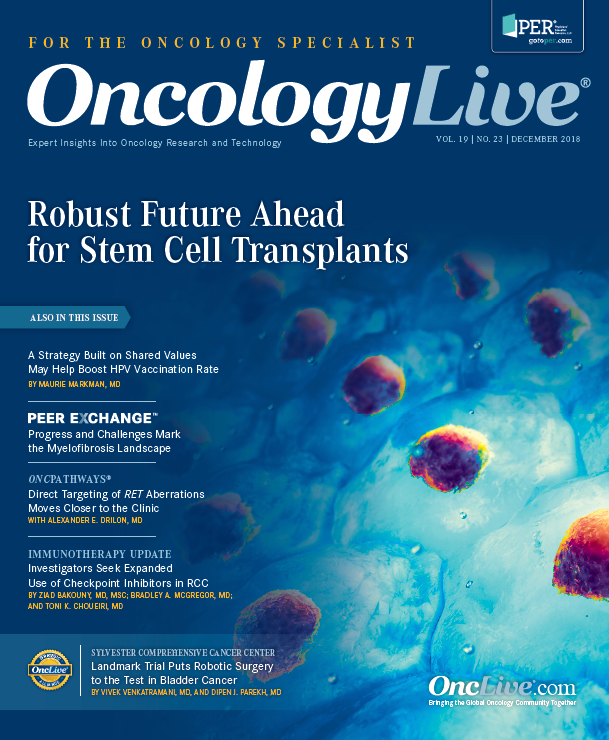Publication
Article
Oncology Live®
Novel Antibody-Drug Conjugate Enters Phase III Trial for Metastatic TNBC
Author(s):
Investigators are optimistic about sacituzumab govitecan (IMMU-132), an antibody–drug conjugate that delivers the chemotherapy metabolite SN-38 to tumor cells expressing the TROP-2 receptor, for patients with relapsed/refractory TNBC.
Aditya Bardia, MD, MPH
Investigators are optimistic about sacituzumab govitecan (IMMU-132), an antibody—drug conjugate that delivers the chemotherapy metabolite SN-38 to tumor cells expressing the TROP-2 receptor, for patients with relapsed/refractory triple-negative breast cancer (TNBC). The multicenter phase III ASCENT trial (NCT02574455) is currently recruiting patients previously treated with at least 2 systemic chemotherapy regimens.
The response rates for standard chemotherapy treatments are low in metastatic TNBC (mTNBC), and clinically there is an unmet need for better therapies, according to Aditya Bardia, MD, MPH, ASCENT’s lead author and director of Precision Medicine at the Center for Breast Cancer, Massachusetts General Hospital Cancer Center, Harvard Medical School, in Boston.
Sacituzumab govitecan combines SN-38, the active metabolite of irinotecan, with a humanized immunoglobulin G antibody targeted against TROP-2, a glycoprotein expressed on more than 90% of TNBC tumors. The conjugate can deliver a higher dose of SN-38 than can be achieved with irinotecan, according to Bardia.
Impressive phase II results, presented at the 2017 San Antonio Breast Cancer Symposium (SABCS), prompted the FDA in July 2018 to grant a priority review designation to a biologics license application for sacituzumab govitecan for mTNBC following at least 2 prior therapies for metastatic disease.
Sacituzumab govitecan elicited an objective response rate (ORR) of 34% in patients with heavily pretreated mTNBC. In the single-arm trial, the ORR was accompanied by stable disease for ≥6 months in 11% of patients, for an overall disease control rate of 45%. The median progression-free survival (PFS) with sacituzumab govitecan was 5.5 months (95% CI, 4.8-6.6) and the median overall survival (OS) was 12.7 months (95% CI, 10.8-13.6).1
In the study presented by Bardia at SABCS, 57 patients had moderate (2+) to strong (3+) TROP-2 expression by immunohistochemistry and 5 had weak or absent staining for the marker. Data were not available for the remaining patients.
The study included 110 patients with a median age of 55 years (range, 31-81). Sacituzumab govitecan was administered at 10 mg/kg on days 1 and 8 of each 28-day cycle, which is the same dose being used in the phase III study. Patients had received a median of 14.5 doses of the medication (range, 1-88) and the median duration of treatment was 4.9 months (range, 0.2-32.1).
The patients’ ECOG performance status was 0 (30%) and 1 (70%), and the median time from metastatic diagnosis to treatment in the study was 1.5 years. Forty-one percent of patients were treated in the third-line setting and 59% were in the fourth line or greater. The most common prior therapies were taxanes (98%), anthracyclines (86%), cyclophosphamide (85%), and platinum agents (75%). Additionally, 17% of patients had received an immune checkpoint inhibitor. Most patients had visceral metastases (80%).
By blinded independent central review, the ORR was 31%, which confirmed findings seen in the local assessment, Bardia said. By local assessment, there were 3 complete responses (CRs) and 34 partial responses (PRs). There were 6 CRs and 28 PRs in the blinded review. A target lesion reduction was seen in approximately 74% of patients, suggesting that most patients experienced some type of response to the medication.
Sacituzumab govitecan is “like a smart bomb, because the drugs are delivered directly into the tumor. So, with this particular drug, when you attach it to an antibody straight to the tumor, you actually deliver 7-and-a-half times more drug than you’d normally be able to give. That’s the reason why we’ve seen such good results so far,” said Linda Vahdat, MD, chief of Medical Oncology and clinical director of Cancer Services at Norwalk Hospital, Connecticut, and a lead investigator in the trial. She also sees patients at Memorial Sloan Kettering Cancer Center in New York.
“We have worked with this drug for a long time,” said Vahdat. “I was [previously] with the Breast Center at Weill Cornell Medicine and we did all of the baseline work on this drug, not just in breast cancer. We were the first to identify that it was particularly active in TNBC and also in small cell lung cancer and bladder cancer.”
Figure. Ascent Phase III Study Testing Sacituzumab Govitecan in TNBC2
In ASCENT, patients will be randomized to 10 mg/kg sacituzumab govitecan on days 1 and 8 of 21-day cycles versus treatment of physician’s choice: eribulin, capecitabine, gemcitabine, or vinorelbine (Figure).2 Projected enrollment is 488 from among 150 institutions in North America and Europe. Treatment will continue until progression, unacceptable toxicity, study withdrawal, or death. Follow-up is every 4 weeks during the first year and every 8 weeks thereafter. The primary outcome measure is PFS, and secondary measures are OS, ORR, and duration of response. “We ultimately want to see good shrinkage of the tumor,” said Vahdat. “TNBC involves big tumors that are aggressive, so we [also] want responses to be durable.”
Vahdat said that getting the word out about the study has been the biggest challenge in getting patients interested in participating. “The study actually has been very easy to accrue because [sacituzumab govitecan] is a very active drug and patients with TNBC tend to be good advocates for themselves,” she said. “They understand that it’s useful to them to have new drugs.”
References
- Bardia A, Vahdat LT, Diamond J, et al. Sacituzumab govitecan (IMMU-132), an anti-Trop-2-SN-38 antibody—drug conjugate, as ≥3rd-line therapeutic option for patients with relapsed/refractory metastatic triple-negative breast cancer (mTNBC): efficacy results. Presented at: 2017 San Antonio Breast Cancer Symposium; San Antonio, Texas, December 5-9, 2017. Abstract GS1-07.
- ASCENT: study of sacituzumab govitecan in refractory/relapsed triple-negative breast cancer (ASCENT). clinicaltrials.gov/ct2/show/NCT02574455?term=immu-132&rank=5. Updated August 8, 2018. Accessed November 15, 2018.










